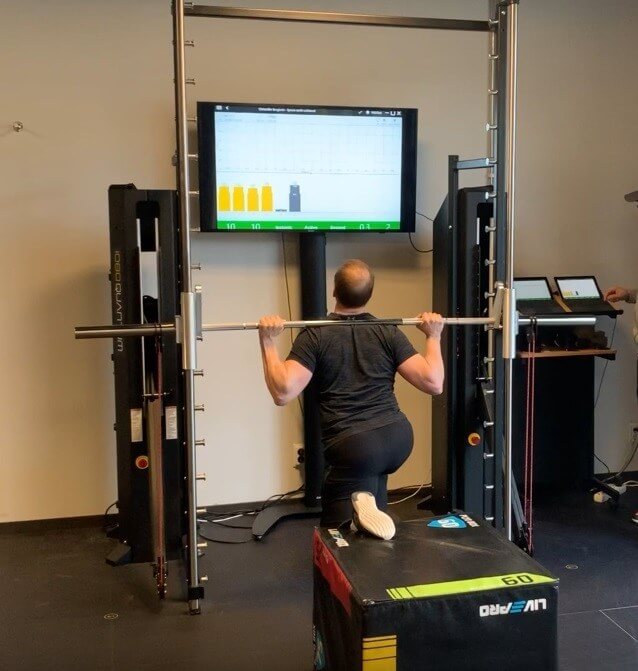Looking for a way to monitor an athlete’s strength and still have time to train during the session? 1080 Motion technology measures maximal force in real time during every repetition, providing an alternative to traditional one-repetition maximum (1RM) testing. Quickly set up a multi-joint movement testing session with the touchscreen to add resistance for a bilateral squat movement. Accurately compare maximum force produced between unilateral right and left movements signaling a possible deficit following injury.
More than just a number indicating maximum weight lifted, 1080 Motion data provides insight into peak and average force through the entire concentric movement. Distance of the movement and time under tension during each repetition is recorded. Visual display of each repetition’s force output and force-curve can show quality of the movement.
Let’s dive deeper into using the 1080 Quantum to accurately and efficiently determine force output of multi-joint movements. 1 Learn how to use a low speed setting (isokinetic resistance) to perform one set of five repetitions to measure average force. Average force is then a good estimate of force capacity of the multi-joint exercise.
Purpose: Assess maximum concentric force of kinetic chain movement patterns to monitor individualized training plan
Movements: Bilateral Squat and Rear-Foot-Elevated Split Squat
Equipment: 1080 Quantum Syncro (Quantum x 2) using a squat plate
Assessment Method: 1080 Quantum offers isokinetic resistance from the ability to set a concentric speed restriction. Based on the versatility of 1080 Quantum, maximum force of kinetic chain movement patterns can be obtained.
How it Works
As a testing tool, the 1080 Quantum can measure both peak and average force of a movement. One single Quantum can assess up to 1400 Newtons (N). For stronger athletes, two Quantums can sync together into a 1080 Syncro system testing up to 2800 N of maximum force utilizing the squat plate or Smith machine.
The Set-Up
Movement A: Bilateral squat
Measurement: Concentric (peak and average) force
Method: Set concentric and eccentric resistance to a minimum of 5 kg. Type of resistance mode can be freely selected as either normal, isotonic, or ballistic (NFW). Mode will not impact isokinetic speed as a constant speed is assumed. Set-up system to gear 2 as higher force output is expected. Then, set concentric speed to 0.3 m/s to create isokinetic resistance when athlete assumes the set speed. Set eccentric speed to 2 m/s. With a designated squat belt donned, set up athlete’s feet with center of body over squat plate pulley. Perform a squat to desired testing depth and repeat for 5 maximum effort repetitions.
The athlete in the demo video performs five repetitions of a bilateral squat. To assess average force produced during each repetition, delete the repetitions with the highest and lowest average force output. Select Average within the view options under the More heading and the remaining three force measurements will estimate 1 repetition maximum (1RM) at 0.3 m/s velocity. Each repetition will produce a bar indicating average force value (lower number) throughout the concentric excursion phase and peak force value (higher number) recorded during the repetition.


Movement B: Rear-foot-elevated split squat
Measurement: Concentric (peak and average) force by utilizing 1080 Syncro and Smith machine
Method: Set concentric and eccentric resistance to a minimum of 5 kg. Type of resistance mode can be freely selected as either normal, isotonic, or ballistic (NFW). Mode will not impact isokinetic speed as a constant speed is assumed. Set-up system to gear 2 as higher force output is expected. Then, set concentric speed to 0.3 m/s to create isokinetic resistance when athlete assumes the set speed. Eccentric speed set to 2 m/s.
Perform a left single leg squat by placing shoulders and left foot directly underneath the bar. Right foot is placed on elevated pad. Perform squat to desired testing depth and repeat for 5 maximum effort repetitions.
Our athlete in the demo video performs five repetitions of a single leg squat on the left and right. Looking at average force produced during each repetition, delete the highest and lowest average force output repetitions. Select Average within the view options under the More heading and the remaining three force measurements will estimate 1RM at 0.3 m/s velocity. Each repetition will produce a bar indicating average force value (lower number) throughout the concentric excursion phase and peak force value (higher number) recorded during the repetition.

Key Takeaway:
The 1080 Quantum and Syncro system provides an efficient solution to measure max force production of bilateral and single leg movements to precisely measure neuromuscular capability at a set speed and monitor an individualized training program.
[av_button_big label=’Previous edition of 1080 In Session:’ description_pos=’below’ link=’manually, https://1080motion.com//1080-in-session-load-velocity-profile-broad-jump/’ link_target=” icon_select=’no’ icon=’ue800′ font=’entypo-fontello’ custom_font=’#ffffff’ color=’theme-color’ custom_bg=’#444444′ color_hover=’theme-color-subtle’ custom_bg_hover=’#444444′ av_uid=’av-154cfr9′]Creating a Load-Velocity Profile—Broad Jump[/av_button_big]
References
- Whinton, Alanna K., et al. “Testing a novel isokinetic dynamometer constructed using a 1080 Quantum.” PloS one13.7 (2018).






























































